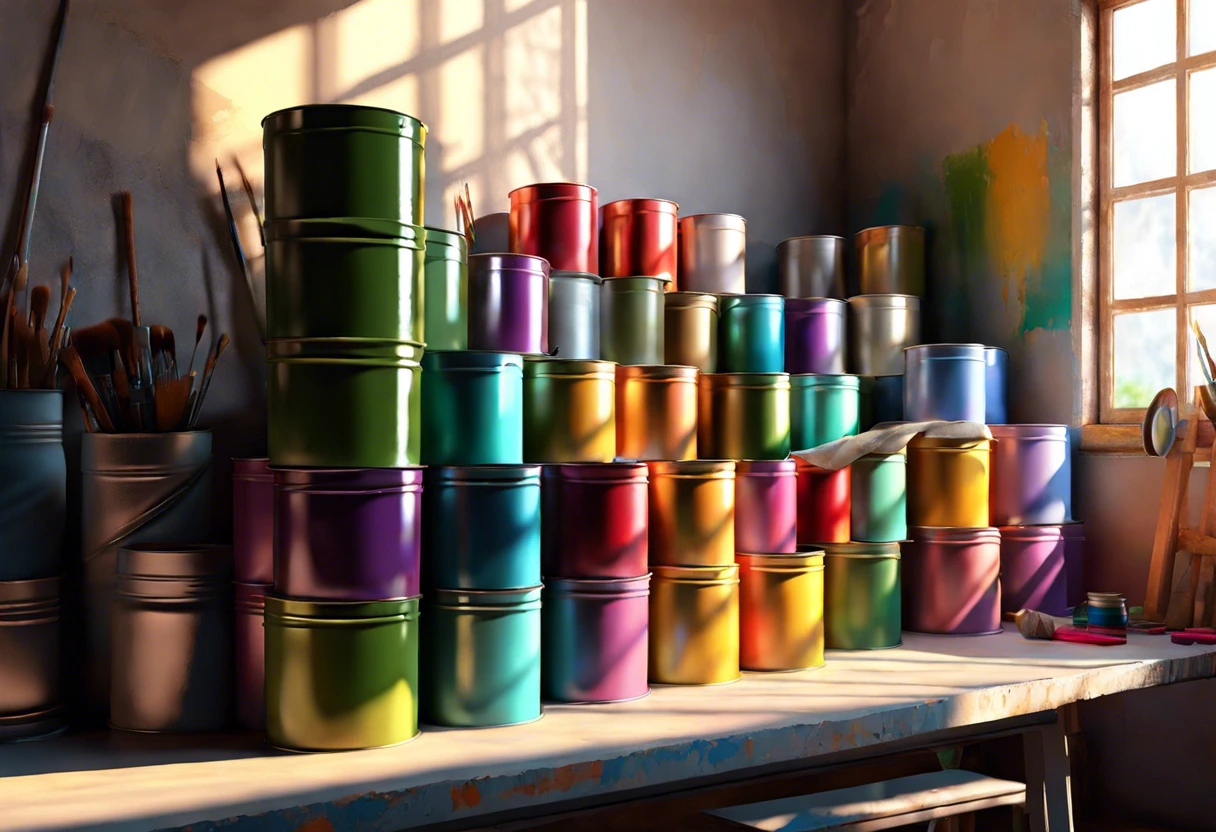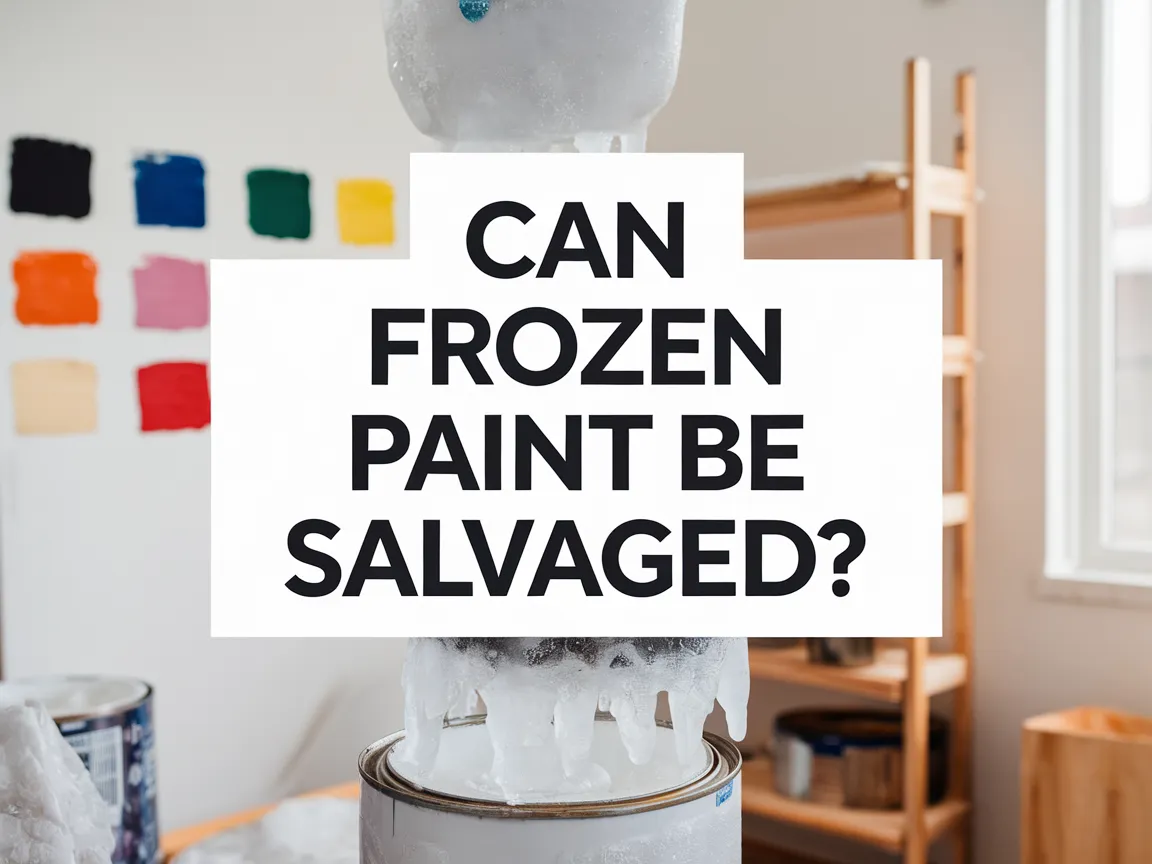Can You Throw Away Old Paint?
Published on: April 20, 2025 | Last Updated: January 7, 2025
Written By: Sarah McClintock
Old paint is the stuff left in cans after you’ve finished a painting project. It’s like leftover food that you forgot about in the fridge!
Can you throw away old paint? It’s super important to handle this correctly. I’ve accidentally tossed some old paint before, only to discover it could harm our environment.
In this article, you’ll learn about essential considerations for paint disposal methods, proper steps to take, eco-friendly practices, types of paint and their disposal needs, common disposal issues, and even fun DIY project ideas using leftover paint. Getting rid of old paint safely matters, so let’s dive in!
Contents
- 1 Can You Throw Away Old Paint?
- 2 What is ‘Old Paint’?
- 3 Before You Start: Essential Considerations for Disposing Of Old Paint
- 4 Steps to Properly Dispose Of Old Paint
- 5 Alternatives to Throwing Away Old Paint
- 6 Understanding Paint Thinners and Solvents
- 7 Types Of Paint and Their Disposal Implications
- 8 Factors Affecting the Disposal Of Old Paint
- 9 Common Issues When Disposing Of Old Paint
- 10 Environmental Impact of Improper Paint Disposal
- 11 How to Find Local Disposal Options
- 12 Paint Donation Centers Near You
- 13 Finishing Touches: Ensuring Your Paint is Disposed Of Correctly
- 14 DIY Project Ideas Using Leftover Paint
- 15 Frequently Asked Questions (FAQs)
- 16 Conclusion: Best Practices for Disposing Of Old Paint Responsibly
- 17 Useful Resources
Can You Throw Away Old Paint?
You can’t just toss old paint in the trash. It may be hazardous waste, especially oil-based paint. Check local guidelines for safe disposal or recycling options. If you’re looking to refresh your space, you might want to explore professional bathtub painting techniques. Always handle paint responsibly to protect the environment!
The Finishing Touch
A freshly painted wall is a blank canvas. The best way to bring your room to life is with a single piece of statement art that ties everything together.
Browse Wall Art at Big Wall DecorWhat is ‘Old Paint’?
‘Old Paint’ refers to paint that has deteriorated in quality due to age or improper storage, making it unusable. Typically, paint can go bad after 10 years; about 90% of paints can expire before that. When working with specific surfaces like aluminum boats, choosing the right paint becomes crucial for protecting marine equipment effectively.
I’ve had my share of trouble dealing with old paint. Once, I mixed some poorly stored acrylics in an attempt to salvage them, leading to a gooey disaster.
I often used it for art projects in unexpected ways. You won’t believe what happens when you try to remove dried latex paint from brushes—I ended up using vinegar and hot water. It worked, but it was a messy process! Learning how to dispose of old latex paint properly could’ve saved me a lot of hassle.
If you’re exploring digital art techniques, you might want to explore advanced animation features that can enhance your creative workflow. adding audio to digital animations can transform your artistic projects.
Before You Start: Essential Considerations for Disposing Of Old Paint
What do you need to get started?
- Safety Gear: You’ll need gloves and a mask, like the N95 Respirator, to protect yourself from toxins in the paint.
- Sealable Containers: Use containers, such as a five-gallon bucket with a lid, to store leftover paint safely.
- Old Rags: Keep some old rags handy. They’re useful for cleaning spills quickly and preventing paint waste.
- Labeling Supplies: Grab label stickers to identify the types of paint you plan to dispose of, ensuring proper handling.
We covered key factors to consider when disposing of old paint. We will now cover the steps for proper disposal.
The Finishing Touch
A freshly painted wall is a blank canvas. The best way to bring your room to life is with a single piece of statement art that ties everything together.
Browse Wall Art at Big Wall Decor
Also See: How to Paint a Tractor? Simple Steps for Success

Steps to Properly Dispose Of Old Paint
Here are the steps to address the question: what to do with old paint.
-
Assess the Condition Of Your Old Paint
Examine your paint cans closely. If it’s dried up or chunky, it’s time to toss it.
Unopened paint in good condition may be reusable within three years. If it looks solid, don’t waste it!
-
Determine the Type Of Paint
Check if your paint is water-based or oil-based. Most latex (Water-based) paints are easier to dispose of and can often go in your regular trash.
Oil-based paints are hazardous waste and need special disposal methods, like community collection events. Read the label to see which category it falls under.
-
Review Local Regulations
Local laws vary on how to dispose of paint. Call your local waste management or check their website for details.
Many areas hold hazardous waste disposal days. Find out when these events occur.
-
Explore Reuse and Donation Options
If your old paint is still usable, offer it to neighbors or donate it to local charities. Organizations like Habitat for Humanity accept paint donations.
These groups greatly appreciate any donations of usable supplies, especially for home improvement projects.
-
Prepare Paint for Safe Disposal
For latex paint, mix it with absorbent materials like cat litter. This will dry it out, making it safe to throw away with your household trash.
For oil-based paints, transport them to a hazardous waste facility. Proper venting during transportation will prevent spills. Think it’s a hassle? I understand—just plan ahead! When you need specific guidance on handling paint containers, check out key paint container techniques.
So far we covered how to properly dispose of old paint. Let’s look at alternatives to discarding old paint next.
Alternatives to Throwing Away Old Paint
If you find yourself wondering, “What can I do with this old paint?”, you have options beyond disposal!
-
Repurposing Old Paint
Turn that old paint into something fabulous! Use it for:
- Furniture Makeovers: Revitalize old furniture with a fresh coat.
- Craft Projects: Create unique artwork, signs, or decorations.
- DIY Gifts: Paint flower pots or wooden birdhouses for a personal touch.
-
Community Paint Swaps
Engage with your community. Many towns hold paint swaps:
- Share Your Paint: Bring your unwanted paint to swap out for colors you like.
- Meet Fellow DIYers: Connect with others who share your passion.
-
Art Programs
Your old paint can find a new life in:
- Schools: Many art programs gladly accept paint donations for student projects.
- Nonprofits: Offer paint to community centers or charities conducting art workshops.
You should now have a good understanding of options for disposing of old paint. In the next part, we’ll discuss paint thinners and solvents.
Understanding Paint Thinners and Solvents
How do paint thinners fit into all of this? They can help in several aspects of paint use.
| Type | Usage | Disposal Method |
|---|---|---|
| Mineral Spirits | Cleaning tools and brushes | Check local hazardous waste guidelines |
| Acetone | Removing heavy paint stains | Local hazardous waste disposal only |
| Water-based Thinner | Diluting water-based paints | Dispose in regular trash if dried out |
Remember, properly identified solvents can often be reused. Always check their condition before disposal to maximize their lifespan!
You should now have a good understanding of paint thinners, solvents, and their uses. In the next part, we’ll discuss paint types and disposal considerations.

Types Of Paint and Their Disposal Implications
Let’s discuss types of paint and their disposal methods: Latex, Oil-based, Spray Paint, and Specialty Paints.
-
Latex Paint
Latex paint is water-based and popular for its quick drying time. Don’t throw away old paint in the trash; instead, let it dry or mix it with cat litter for safe disposal.
-
Oil-based Paint
Oil-based paints contain solvents, making them hazardous waste. You can’t throw them away—find a local facility that accepts these paints.
-
Spray Paint
This type often comes in aerosol cans containing flammable propellants. Don’t discard them in your regular trash; take them to a household hazardous waste program instead.
-
Specialty Paints
Specialty paints, such as those for textured finishes or crafts, may have unique components. Disposal depends on the label; some require hazardous waste disposal while others can be dried and discarded.
Having dealt with similar challenges, I’ve found that using latex paint cans for simple DIY projects helps me avoid waste. Plus, it keeps my supplies organized and looks nice!
Factors Affecting the Disposal Of Old Paint
What factors influence your decision to dispose of old paint?
-
Type of Paint: The type of paint, such as latex or oil-based, affects disposal methods.
-
Local Regulations: Different areas have rules about paint disposal, so check local regulations before you dispose of it.
-
Containers: The packaging of your paint can impact how easily you can throw it away.
-
Amount: The quantity of leftover paint can determine which disposal methods to consider.
Common Issues When Disposing Of Old Paint
My friend tried to toss out old paint and got fined! Local laws prohibit throwing it in the trash.
The Finishing Touch
A freshly painted wall is a blank canvas. The best way to bring your room to life is with a single piece of statement art that ties everything together.
Browse Wall Art at Big Wall DecorTo dispose of old latex paint, let it dry, mix it with cat litter, and check waste management guidelines. I recommend using a certified collector—55% (Fifty-five Percent) avoid fines this way!
Environmental Impact of Improper Paint Disposal
Ever wondered what happens to our planet when we toss old paint the wrong way? The effects can be alarming.
- Soil Contamination: Chemicals from paint seep into the soil, affecting plants and animals. A single can of oil-based paint can contaminate up to 1 million gallons of water!
- Water Pollution: Paint can wash into waterways, harming aquatic life. Paint waste is a leading cause of pollution in lakes and rivers.
- Air Quality: Volatile Organic Compounds (VOCs) in paint evaporate, contributing to smog and respiratory problems.
- Health Risks: Improper disposal can lead to hazardous conditions, increasing risks of skin and respiratory issues.
How to Find Local Disposal Options
Finding a disposal option doesn’t have to be difficult! Here’s how you can locate a place near you:
-
Visit Local Government Websites
Start with your city or county’s waste management site. They often provide lists of recycling centers.
-
Use Online Resources
Websites like Earth911 let you search for disposal locations by entering your zip code.
-
Contact Community Centers
Local community centers may host disposal events. Just give them a call or check their bulletin boards!
Paint Donation Centers Near You
Not sure where to donate? Here’s a quick table of potential donation spots.
| Donation Center | What They Accept | Contact Information |
|---|---|---|
| Habitat for Humanity ReStores | Usable paint, supplies | Visit Here |
| Local Schools | Usable water-based paints | Call for specific needs |
| Community Art Programs | All types of paints | Search online or local listings |
Finishing Touches: Ensuring Your Paint is Disposed Of Correctly
After finishing your old paint, let the remnants dry completely. Use a mix of sawdust or kitty litter in a sturdy container.
Inspect cans for solidified paint or product numbers before disposal. Use generic products like VariGuard paint or my trusted brand, Rust-Oleum, for clear material information.
If you’re experienced, consider recycling the empty cans at your local facility. Look for local hazardous waste days—many places hold them twice a year!
DIY Project Ideas Using Leftover Paint
How about turning leftover paint into vibrant garden markers? You could also try creating funky wall art by pouring paint onto canvas—who doesn’t love splashes of color?
For the garden markers, just paint wood scraps, and seal them. It’ll cost you about $10-$20 and only take an hour! The canvas art might run $15 to $30, plus a couple of hours in total for drying time.
Instead of tossing old paint, think about donating it to schools or community centers—they’re often super grateful! If you’ve got paint that’s dried up, crush it and mix it into concrete for raised garden beds—talk about recycling with flair! Paint preservation and creative reuse have fascinating technical nuances, which is why experts explore unique paint application techniques.
Also See: How Do You Dispose Of Empty Paint Cans? Easy Steps
Frequently Asked Questions (FAQs)
How Do You Dispose Of Old Latex Paint?
Yes, you can safely dispose of old latex paint with specific steps. To dispose of latex paint, first let it dry out or mix it with cat litter to absorb moisture. Local waste regulations may require this to prevent landfill hazards.
How to Remove Dried Latex Paint From a Brush?
Removing dried latex paint from a brush is simple. Soak the brush in warm, soapy water for several hours, then comb through the bristles to remove the paint. This method can extend the brush’s life and keep it usable for future projects.
What Are the Dangers Of Improperly Disposing Of Paint?
Improper disposal of paint is hazardous. It can contaminate soil and water sources, affecting both ecosystems and human health. Paint contains chemicals that may cause respiratory or skin issues, increasing health risks if left unchecked. If you’re working with alternative materials like clay, you might want to learn about paint safety that minimize environmental and health impacts.
Is It Okay to Let Paint Dry Out and Throw It in the Trash?
Yes, it’s generally okay to let paint dry out and then throw it in the trash. This method reduces the risk of spills or leaks, following most local guidelines. Make sure to check specific regulations to ensure compliance with disposal procedures. If you’re looking to repurpose leftover paint or explore creative disposal techniques, you might want to discover artistic painting alternatives.
What Can You Do With Leftover Paint Instead Of Throwing It Away?
You can reuse leftover paint rather than throwing it away. Consider donating it to community centers, schools, or churches that often welcome paint donations. This extends its life and keeps it from ending up in landfills needlessly. If you’re wondering about alternative uses for paint, such as painting bathroom tiles effectively, there are creative solutions to repurpose your extra paint.
Conclusion: Best Practices for Disposing Of Old Paint Responsibly
We covered essential points like what qualifies as ‘old paint’, steps to dispose of old paint properly, types and their disposal implications, factors affecting disposal, and common issues faced when getting rid of old paint.
So, can you throw away old paint? In short, it’s best to explore eco-friendly methods like recycling or drop-off centers to avoid any harm to the environment. If you need additional advice, I’m here to help with any disposal inquiries or DIY tips.
For further guidance and resources on responsible paint disposal, visit Paint Answers.
Useful Resources
- Gurney, J. (2009). Color and Light: A Guide for the Realist Painter. Kansas City, MO: Andrews McMeel Publishing.
- How to Store and Dispose of Paint | Lowe’s









